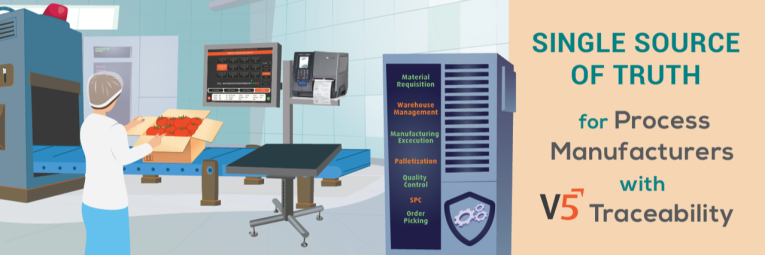
- Home
- Allergen Control
- Single Source of Truth for Process Manufacturers
Allergen Control

Single Source of Truth for Process Manufacturers
Problem or Opportunity?
In today’s fast-paced manufacturing landscape, businesses relentlessly pursue consistent and reliable information across their operations. This drive has led to the widespread adoption of Enterprise Resource Planning (ERP) systems. These robust systems have transformed disparate back-office applications and databases into a unified, comprehensive solution, all anchored by a common database. The primary goal? Establishing a single source of truth for businesses, enabling agile real-time decision-making.
The Role of ERP Systems
As businesses enthusiastically embrace technological advancements, they encounter new, diverse, and business-critical applications aimed at enhancing operational efficiency. Executive management universally acknowledges the need for these systems to seamlessly integrate with ERP systems to maintain this critical single source of truth. This integration extends across all facets of a business, particularly concerning operational data.
Challenges on the Shop Floor
However, a notable integration challenge looms on the shop floor of most process manufacturing operations. This article highlights the challenges faced by modern process manufacturing.
Real-Time Tracking of Raw Material Consumption
For many process manufacturers, there remains a significant deficiency in tracking real-time raw material consumption during production. Traditionally, raw materials were manually extracted from inventory and recorded, often using pen and paper. These materials were then manually measured and weighed before being added to each production batch, all without sufficient checks and balances to ensure formula compliance. This manual and error-prone process not only jeopardizes accuracy but also makes it nearly impossible to track actual consumption.
Complexities of Lot Traceability
The lack of proper controls and integration becomes even more problematic in manufacturing processes involving consumable goods, such as food production, supplements, pharmaceuticals, and other regulated industries where lot number traceability is a requirement. In most process manufacturing environments, lot traceability is typically carried out manually, often using pen and paper. Just like tracking actual inventory consumption, this process is prone to errors.
Furthermore, the information collected must be manually entered into either the ERP or reporting systems to comply with regulatory standards. Not only does this introduce an additional opportunity for human error, but it also demands costly manpower to complete. Additionally, when raw materials become part of a sub-mix, it becomes virtually impossible to accurately trace lot numbers all the way through to the final product. The lack of precision in lot traceability introduces additional risks for both manufacturers and consumers.
The Solution: SG Systems V5 Formula Control
Enter SG Systems V5 Formula Control, an innovative solution designed to automate inventory consumption and lot traceability management at the point of production, extending seamlessly through to the shipping of finished goods. This system enforces checks and balances that ensure strict adherence to formulas and processes, ensuring precision at every stage. Inventory is depleted in real-time, and policies, such as the “first expiry, first out” basis, can be systematically enforced.
Benefits of SG Systems V5 Formula Control
The advantages are extensive:
- Real-time Visibility to Raw Material Consumption: SG Systems V5 Formula Control provides manufacturers with real-time insights into raw material consumption, eliminating guesswork and ensuring data accuracy.
- Improved Product Consistency: Automating formula control enhances product consistency, reducing variability, and ensuring that every batch meets stringent quality standards.
- Reduction in Raw Material Usage: On average, process manufacturers can achieve a 4-6% reduction in raw material usage, contributing to cost savings and sustainability efforts.
- Reduction in Rework: By enforcing strict formula control, rework due to formula inaccuracies is minimized, leading to increased operational efficiency.
- Process Enforcement: SG Systems V5 Formula Control acts as a guardian of quality, ensuring that production processes adhere to predetermined standards and protocols.
- Automated, FDA/FSMA Quality Lot Traceability: Compliance with regulatory standards is seamlessly achieved, reducing the risk of costly non-compliance penalties.
- Allergen Identification and Notification: The system can identify allergens and issue timely notifications before production, reducing the risk of allergen-related incidents.
- Safety Notifications: The system can proactively notify operators and management of safety concerns, enhancing workplace safety.
- Reduction in Human Error: By automating processes, SG Systems V5 Formula Control reduces the potential for human error, resulting in greater accuracy and consistency.
- Reduction in Required Manpower: Manual tracking of inventory usage and lot traceability is minimized, leading to cost savings and a more efficient workforce.
Conclusion
In conclusion, the modern manufacturing landscape demands precision, efficiency, and compliance. Automating formula control and lot traceability with real-time integration to ERP and back-office systems, as exemplified by SG Systems V5 Formula Control, is not merely a technological innovation; it is a necessity for any process manufacturer aiming to thrive in today’s highly regulated and competitive environment. This seamless integration signifies the future of manufacturing, where data-driven decisions, operational excellence, and compliance with regulatory standards converge to drive success and sustainability.
North America
SG Systems LLC
4101 McEwen #240, Dallas TX 75244
Phone: +1 214 819 9570
Contact us here
United Kingdom
SG Systems Europe Ltd
Suite 3 Walton Summit Centre, Green Place, Four Oaks Rd, Preston, PR5 8AY
Phone: +44 (0) 114 349 1480
Contact us here
Australia
Wedderburn
101 Williamson Road, Ingleburn NSW 2565
Phone: +61 2 9426 1800
Contact us here
Europe
SG Traceability Systems Ltd
31-32 Greenmount Office Park, Harolds Cross, Dublin D6, Ireland
Phone: +44 (0) 114 349 1480
Contact us here
Rest assured, we value your privacy and are committed to keeping your data safe. By clicking "Continue with recommended settings," you're giving us permission to use cookies. Of course, you're in control – feel free to adjust your cookie settings anytime in our Privacy Preferences.